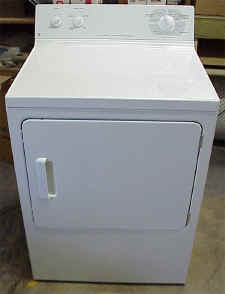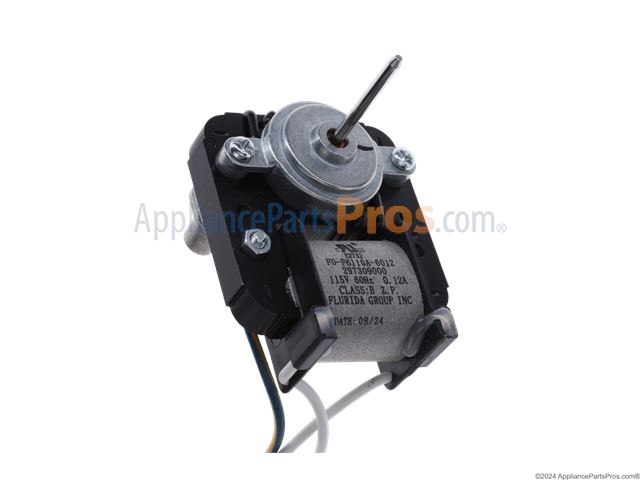GE Dryer Troubleshooting
GE style Dryers, Hotpoint, Moffat, McClary....
Always remember Electricity is dangerous and should be treated with respect.
Please pick a topic by Make and problem...hope you find this helpful :-)
We have tried to split up some of the GE dryer repair helps into the older style and newer style sections....but there are some Frigidaire built dryers out there with the GE name/Logo on them that will not look like either!

Older style dryer has a darker colored drum

Newer style GE dryer has a lighter colored drum
Quick Info Tips
Q: Dryer takes too long to dry or multiple times to dry a load.
A1: Pull the dryer out away from the wall. Unhook the vent from the dryer completely. Do not put anything over the dryer exhaust on the back of the dryer. Do a normal load with the vent unhooked. If it dries better or ok like this then the problem is in the dryer venting. Like a blocked vent pipe or a smashed or restricted vent hose.
A2: If the vent doesn't make a difference, then check the blower wheel for excessive lint build up, check that there isn't anything stuck to the air intake baffle inside the drum, (i.e. the screen on the back wall of the dryer when looking into the drum). Check the lint filter chute for blockage. Check that the heating element isn't shorted to ground. Check the exhaust temperature of the dryer. A pocket thermometer can be used for this. It should cycle approx between 120 degrees and 160 degrees (without clothes). Check that the drum seals are not worn out.
Q: My electric dryer runs but will not heat, what could stop my dryer from heating?
A: Things that could stop a electric dryer from heating: house fuse or breaker ( needs two of them ), heating element, burnt wire, thermostat(s), thermal fuse ( not all models ), motor heat switch, timer, selector switch, burnt power cord/plug.
A ohm meter test for these parts.
Q: My gas dryer runs but will not heat, what could stop my dryer from heating?
A: Things that could stop a gas dryer from heating: glow bar igniter, thermal fuse ( not all models ), coils on the gas valve, gas valve, thermostats, motor heat switch, timer, selector switch, sensor. A page for checking gas dryers.
- Changing from 3 to 4 wire hookup on a electric dryer
- Dryer basics - timers and how they work
- Dryer basics - Dead dryer
- Dryer basics - power cord problems
- Dryer help repair flow chart.
- For all dryers: Dryer tip 1 Dryer tip 2 Dryer tip 3 - Dryer Tip 4
- Dryer basics - venting problems and power supply problems
- Dryer basics - how long can my dryer vent be in length?
- Gas dryer smell
- GE style dryer noises
- GE style electric dryer with no heat element help as well
- GE newer style dryer - how to take apart
- GE style dryer - how to take apart
- GE style dryer - how to take apart slide show - really old style
- GE style dryer - black streak like marks on my clothes front glide repair
- GE style gas dryer with no heat
- GE style dryer belt change
- GE dryer - wiring the motor switch
- GE dryer - common motor problems
- GE style - where are the thermostats
- GE style dryer *some* intermittent or low heat complaints
- Help for storing an appliance
- How do dryer thermostats work?
- How the belt is supposed to look at the motor and idler pulley
- I had to repair my own dryer - with take apart helps
- Important Disclaimer
- If your drum belt looks like either of these...change it
- Pilot flame help
- Sample wiring diagrams
- Slide show - how to take apart for the older GE dryer
- Test for ohm meter checking on electric dryers with no heat
- What is a grounded element?
GE style dryer noise:
Listen to the noise carefully, a slow or fast noise can help point you in the direction to look for the trouble maker.
Slow squeaking or scraping noises are often from the front glides ( there are 2 of them to change ) or rear bearing area, the rear bearing sleeve is inside the middle of the heater housing and the shaft part is attached to the back of the drum. This is a typical rear bearing kit for the older style GE dryer. This is a typical front glide kit for the older style GE dryer. For faster sounding squeaking or scraping noises, poss problems would be in the idler pulley, motor, blower wheel or belt area. This is old style rear bearing sleeve. This is the new style bearing sleeve. This is the new style front glides, there are 3 or 4 of them. This is the support/bearing for the new style front glides.
To replace the front glides on the older style dryer, remove power, see "how to take apart". Once the front is moved off to the side, use a screw driver to hold up the front of the drum while you remove the 2 screws from each glide so you can replace them.
GE style dryer - streak like marks on clothes:
disconnect power first. For black streak marks on the clothes, check and probably change the front glides. The front of the drum has "dropped" due to worn out front glides and the clothes are getting marked and pinched from the front of the drum catching the top of the front panel. To replace the front glides on the older style dryer, remove power, see "how to take apart". Once the front is moved off to the side, use a screw driver to hold up the front of the drum while you remove the 2 screws from each glide so you can replace them.
GE style dryer belt change:
disconnect power first. To change the belt on this style dryer ( new and older styles ), first see "how to take apart". The drum belt in placed around the drum from the front of the dryer, the ribs on the belt go against the drum. Once you have to top and front back on, pull out the dryer and remove the small access panel at the back bottom. The belt must be "looped" around the motor and idler pulley like this. Slowly turn the drum around one turn to line up the belt, to make sure that it will not fall off because of being crooked or twisted.
GE style electric dryer with no heat:
See "how to take apart" as the heating element is behind the dryer drum. On electric dryers, always check the house fuses first!! If you have a volt meter, you should read 240 volts between the red and black wires, 120 volts between the white and black and 120 volts between white and red at the main connection. On older style GE dryers, after the top is lifted up....see the element wire terminals at the back top of the heating cage behind the drum.
On the newer style GE dryer the drum will have to be removed to get at the element terminals as they are hidden behind the drum. Check for 240 volts with a volt meter to all three terminals of the heating elements, proper power there but no heat = bad element. No power there, you must check thermostats ( operating and safety ), motor heat switch ( terminals 1 &2 ), wiring ( look for any burnt connectors ), selector switch or timer contacts. If live volt testing scares you, try the ohm check instead. Check with wiring diagram ( usually found in console area or under the dryer top panel ) for specific wire colors and terminals on the timer and selector switch. You can also check for continuity between all three terminals of the heating element, if no continuity...the element is open and you need a new one. The older style replacement element ( WE11X10007 ) usually comes with directions/repair sheet, I find it best to stretch the element slightly shorter than the directions say. The newer GE dryer element often comes with the element pre-installed in a cage assembly, there -may- be a restring kit available, but often this element comes with the can cage all together. Sometimes because of a bad vent, the element can stretch and touch each other, use the "how to take apart" to remove the drum and do a visual check of the heating element coils. Sometimes one cycle like the "regular" might not heat but the "permanent press" timer cycle will heat. A couple of things to check, one is to set dryer on the cycle that won't heat and wiggle the timer knob to see if the heat will work, sometimes the contacts in the timer get loose and they can quit in one cycle but work in another, you will need to replace the timer. Another thing to check would be the wires going to the operating thermostats, one wire could burn off the delicate thermostat, giving no heat in the delicate cycle but the regular might still work.
GE style dryer thermostat:
Operating thermostats can be found on the fan blower duct area, the older style dryer has them just under the lint filter, the newer style dryer has the operating thermostats right beside the motor on the fan blower housing. Safety thermostats can always be found on the heating element cage housing.
Related Links
- General Electric Dryer Heating Elements
- General Electric Dryer Knobs, Dials & Buttons
- General Electric Dryer Support Parts













